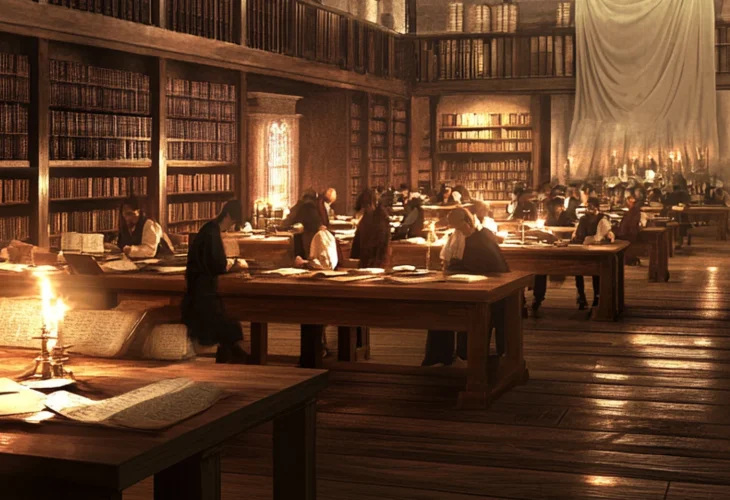History and Archaeology
From Housewife to Torah Leader: The Story of Rebbetzin Miriam
How one remarkable woman, raised among scholars, became the head of a medieval yeshiva in Speyer

The roots of Ashkenazi Jewry trace back to Cologne, from which Jews later moved to the famous three communities of SHUM: Speyer, Worms, and Mainz. Interestingly, Jews lived in Worms and Mainz before settling in Speyer. At that time, the arrival of Jews in a new city was not always welcomed. After the death of Emperor Louis the Pious in 840, conditions for Jews in the Rhine area worsened. But history soon took an unexpected turn.
In 1084, more than 700 years after Jews first settled in Cologne, Bishop Ruediger Huzmann of Speyer decided his city needed Jews. He invited them to settle there, promising protection and rights. In his remarkable letter, preserved as a historical document, he wrote:
“I, Ruediger Huzmann, Bishop of Speyer, by elevating Speyer to a city, thought I would greatly enhance our esteem by bringing in Jews to reside here. I settled them outside the existing community and housing of other residents. To prevent them from being easy targets of the crude mob, I encircled them with a wall. I granted them license and rights to trade gold and silver as they please... and just as the civic judge rules among citizens, so too does their synagogue leader among Jews... In complex matters, the bishop will intervene. They are permitted to hire our wet-nurses. Meat forbidden to them by their religion is allowed to be sold to Christians, and Christians may buy it... To mark this for posterity, I have signed and sealed this document on September 13, 1084.”
That very year, a fire in Mainz had left many Jews homeless, and so they accepted the bishop’s invitation. Soon, Speyer became a flourishing Jewish community. The bishop even built a magnificent cathedral still standing today with funds borrowed from Jewish merchants. Emperor Henry IV endorsed the charter for the Jews of Speyer and entrusted its safekeeping to Rabbi Kalonymus of Speyer, a descendant of the famous Rabbi Kalonymus, sometimes called “the Jewish King.”
The synagogue in Speyer, which still exists today, became a witness to many extraordinary events. If its walls could speak, they would tell of the Jews who gathered there to recite Psalms and prayers during the terrifying days of 1096, when the First Crusade swept through Europe. While the Jewish communities of Mainz and Worms were nearly wiped out, the Jews of Speyer found refuge through a miracle. Bishop John came with his soldiers, sheltered the community inside the cathedral they had helped finance, and guarded them until the marauders retreated.
Not all Jews were able to reach the cathedral, and some were tragically killed. Their martyrdom was mourned in a moving lament by Rabbi Kalonymus:
“I lament the martyred of Ashpira… For the sanctification of the unique name, they heroically unified the name in strength, valiant warriors fulfilling His word quickly, priests, and my young men, ten in total were struck down… In the third month, during the singing of Hallel, in love bound, they surrendered their souls.”
Over the years, the Speyer synagogue welcomed great scholars, including Rashi’s son-in-law Rabbi Isaac ben Asher, known as the Riva of the Tosafists, and Rabbi Eliezer ben Meshullem, a relative of Rashi himself.
But the most remarkable event in its history came in the late 14th century. Around 1380, Rabbi Solomon Shapiro, a great-grandson of Rashi and head of the yeshiva in Speyer, passed away. His son-in-law, Rabbi Samson Luria of Worms, succeeded him but also died soon afterward. With the students left in despair, the local sages did something unprecedented: they appointed Rabbi Samson’s wife, Rebbetzin Miriam of Speyer, as head of the yeshiva.
Raised among Torah scholars and having studied extensively with her father and husband, Rebbetzin Miriam was respected as a teacher of halacha (Jewish law). Rabbi Solomon Luria, the Maharshal, her own descendant later wrote:
“The revered Rebbetzin Miriam, may she rest in peace, led the yeshiva for several days and years, teaching halacha behind a curtain before exceptional students.”
Rebbetzin Miriam belonged to a remarkable family. Her grandson was Rabbi Yochanan Luria, author of Mashiv Nefesh. Another grandson, Rabbi Yechiel Luria, became the first rabbi of Brisk and was an ancestor of the Maharshal. The Luria family traced their lineage back to King David, and their influence spread across Jewish communities in Europe.
Though few details of Rebbetzin Miriam’s life survive, what we do know speaks volumes. A woman descended from Rashi, she earned such deep respect from her community that the scholars of Speyer entrusted her with the leadership of their yeshiva. Her story stands as a testament to her wisdom, her strength, and the profound role she played in preserving Torah in a time of challenge.

